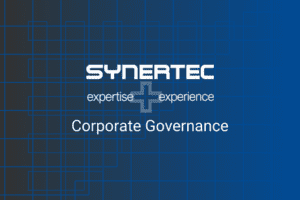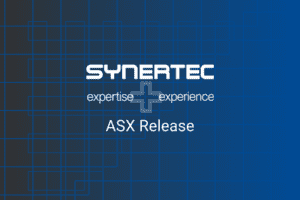SYNERTEC Corporation Limited
ARBN 161 803 032
Audit and Risk Management Committee Charter
The Board of SYNERTEC Corporation Limited (Company) has established an Audit and Risk
Management Committee (Committee). The Committee Chairman’s qualifications and the Committee’s authority, responsibility and specific duties
are described below:
Committee Chairman’s Qualifications
To serve as the Committee Chairman, a director must be independent and shall not be the Chairman of the Board. To be considered independent, a director must meet the criteria for independence required by the Australian Stock Exchange, the Securities and Investment Commission, and any applicable laws and regulations.
An Independent Director is a Director who is not a member of management (a Non-Executive Director)
and who:
- holds less than five per cent of the voting shares of the Company and is not an officer of, or otherwise
associated, directly or indirectly, with a shareholder of more than five per cent of the voting shares of
the Company; - has not within the last three years been employed in an executive capacity by the Company or
another group member, or been a director after ceasing to hold any such employment within the last
three years has not been a principal or employee of a material* professional adviser or a material* consultant to the Company or another group member; - is not a material* supplier or customer of the Company or another group member, or an officer of or
otherwise associated, directly or indirectly, with a material* supplier or customer; - has no material* contractual relationship with the Company or another group member other than as a Director of the Company; and
- is free from any interest and any business or other relationship which could, or could reasonably be perceived to, materially* interfere with the Director’s ability to act in the best interests of the Company.
* the Board considers, ‘material’, in this context, to be where any Director related business relationship has represented, or is likely in future to represent the lesser of at least 10% per cent of the relevant segment’s or the Director related business’ revenue. The Board considered the nature of the relevant industries’ competition and the size and nature of each Director- related business relationship, in arriving at this threshold.
Membership
The Committee’s Chairman shall be designated by the Board.
Committee members shall serve until their successors shall be duly designated and qualified. Any member may be removed at any time by a majority of the Board then in office. Any vacancy in the Committee occurring for any cause may be filled by a majority nominee of the Board then in office.
In addition, to serve on the Committee, a director must be financially literate (or must become so within a reasonable period of time after being appointed to the Committee), as the Board interprets such qualification in its business judgment.
Administrative Matters
The Committee shall meet at least two (2) times annually or more frequently as required.
Any Committee member may and the Company Secretary must, on the request from a member, convene a meeting of the Committee within 7 business days.
A majority of the members of the Committee shall constitute a quorum.
The Committee has a right to access management and seek additional information and explanations
where it considers it appropriate.
The Committee may on the approval of the Board engage independent professional advisors as required.
All minutes will be entered into a minute book and be available at all times for inspection by any director
Authority
The Board has granted the Committee the authority herein provided, as well as the authority to
investigate any activity of the Company and its subsidiaries. The Committee shall be granted unrestricted
access to all information and all employees shall be directed to cooperate as requested by members of
the Committee.
The Committee has the authority to retain, at the Company’s expense, persons having special
competencies to assist the Committee in fulfilling its responsibilities.
Purpose and Responsibilities
The primary responsibility for financial and other reporting, internal controls, and compliance with laws and regulations rests with the management of the Company.
The Committee’s primary purposes are:
- to assist the Board in its oversight of the integrity of the Company’s financial statements, the Company’s compliance with legal and regulatory requirements and corporate policies and controls, the independent public accountant’s selection, retention, qualifications, objectivity and independence, and
- the Committee will assist the Board by reviewing the financial information that will be provided to the shareholders and others, the systems of internal controls that management and the Board have established, and the audit process.
The Committee is responsible for overseeing the:
- integrity of the financial reporting process and that the financial statements adequately
represent the Company’s financial condition, results of operations and cash flows; - Company’s compliance with corporate policies that provide processes, procedures and standards to follow in accomplishing the Company’s objectives; and
- adequacy of the Company’s internal control structure in covering areas that represent high risk for material misstatement of the financial statements.
The independent public accountants shall have direct and unrestricted access to the Committee as well as the opportunity to meet with the entire Board.
Specific Duties
In discharging its responsibilities, the Committee shall have the sole authority to, and shall, do the
following:
- retain and, where appropriate, recommend the termination of the Company’s independent public
accountants; - review and approve all auditing services and related fees and the terms thereof, including the
scope of the independent public accountants’ audit examination plan, procedures and timing of
the audit; - pre-approve any non-audit services (i.e. any services provided other than in connection with the audit
or review of financial statements) to be rendered by the Company’s independent public accountants,
including the terms thereof, and the fees to be paid in connection therewith; - resolve disagreements, if any, between the Company’s independent public accountants and
management; and - assess management’s effectiveness, financial controls, including the Company’s policies and
procedures to assess, monitor, and manage business risk, and legal and ethical compliance programs.
The Committee is also expected to perform the following additional duties:
- Prior to the audit, review the experience and qualifications of the members of the independent public
accountants’ audit team and the quality control procedures of the independent public accountant; - Review with the independent public accountants and management, the Company’s policies and
procedures relative to the adequacy of internal accounting and financial reporting controls, including
the controls over half year and annual financial reporting; - Make all necessary inquiries of management and the independent public accountants concerning
compliance with established standards of corporate conduct; - Review with management and the independent public accountants:
(i) the Company’s policies with respect to risk assessment and risk management,
(ii) the Company’s major financial risk exposures, and
(iii) the steps management has taken to monitor and control such exposures.
- Review with management and the independent public accountants, risks of material misstatement
and the processes and controls implemented by the Company to manage the risks; - Review with management and the independent public accountants, the accounting and reporting principles and practices applied by the Company in preparing its financial statements, including:
(i) issues regarding accounting principles;
(ii) analyses prepared by management and/or the independent public accountants setting forth
significant financial reporting issues, estimates and judgments made in connection with the preparation of the financial statements;
(iii) the effect of regulatory and accounting initiatives on the financial statements of the Company;
and
(iv) reviewing the Company’s policies and procedures for compliance with Australian equivalents to
International Reporting Standards.
- Discuss with management the types of information (including financial information and earnings
guidance) to be disclosed in half year and annual financial statements. - Prior to the release of each half year and annual financial statements, discuss with management and the independent public accountants the results for the half year or the year, including any significant transactions which occurred during the 6 months or the year, any significant adjustments, management judgments and accounting estimates, new accounting policies and any disagreements between management and the independent public accountants.
- Prior to the release of information to the market pertaining to Resources and Reserves and for each annual Resource and Reserve statement, review with the Principal Geologist and/or Responsible Person the reporting procedures and methodology regarding the reporting of Resources and Reserves.
- Prior to the release of the annual financial statements meet to review and discuss with management and the independent public accountants, on completion of their audit, the financial results for the year and the results of the audit, including;
(i) the Company’s annual financial statements and related footnotes, management’s discussion and
analysis of the financial condition and results of operations;
(ii) the results of the audit including the nature and amount of unrecorded adjustments resulting
from the audit;
(iii) the independent public accountants’ management recommendations;
(iv) any significant transactions, management judgments, accounting estimates, new accounting
policies and/or adjustments which occurred during the year;
(v) alternative treatments of financial information within generally accepted accounting principles,
ramifications of the use of alternative disclosures and treatments, and the treatment preferred by the independent public accountants;
(vi) review the Corporate Governance Statement included in the annual financial statement in
accordance with the appropriate ASX Listing Rules; and
(vii) any disagreements between management and the independent public accountants.
- Prior to the release of half year financial statements, meet to review and discuss with management the Company’s half year financial statements, including:
(i) the financial statements and related footnotes, management’s discussion and analysis of the
financial condition and results of operations;
(ii) the result of the quarterly review, including the nature and amount of unrecorded adjustments
resulting from the review;
(iii) any significant transactions, adjustments, critical accounting policies and practices and/or new
accounting policies which occurred during the quarter;
(iv) alternative treatments of financial information within generally accepted accounting principles,
ramifications of the use of alternative disclosures and treatments.
- At least annually:
(i) discuss and review with the independent public accountants all their relationships with the
Company including all non-audit services provided and related fees, and
(ii) discuss with the independent public accountants any disclosed relationships or services that
may impact the objectivity and independence of the accountants and take appropriate action to
satisfy itself as to the independence of the accountants.
- At least annually:
(i) discuss and review with the independent public accountants the firm’s internal quality-control
procedures, any material issues raised by the most recent internal quality-control review, or peer review of the firm within the preceding five years respecting any independent audit carried out by the firm, and any steps taken to deal with any such issues;
(ii) review the independent public accountants’ work throughout the year as it relates to the
Company, including obtaining the opinions of management;
(iii) evaluate the independent public accountants’ (including the engagement partner’s)
performance; and
(iv) present the Committee’s conclusions to the full Board.
- Before the appointment of external auditors for non-audit services, the Audit Committee is to ensure that it is satisfied that the provision of those non-audit services by the auditor is compatible with, and did not compromise the auditor independence requirements of the Corporations Act 2001 for the following reasons:
(i) all non-audit services were subject to the corporate governance procedures adopted by the
Company and have been reviewed by the Committee to ensure they do not impact the integrity and objectivity of the auditor; and
(ii) the non-audit services provided do not undermine the general principles relating to auditor
independence as they did not involve reviewing or auditing the auditor’s own work, acting in a management or decision making capacity for the Company, acting as an advocate for the Company or jointly sharing risks and rewards.
- At least annually review adequacy of risk management policies and procedures including but not
limited to:
(i) Financial budgeting and management reporting
(ii) Limits of authority in areas such as operating and capital expenditure; and
(iii) Operational reporting on the Company’s main operations and special reporting where necessary
on areas such as occupational health and safety, environment etc.
- Meet periodically and separately with each of management and the independent public accountants.
- Review with the independent public accountants difficulties or problems encountered in the course of any audit work, including any restrictions on the scope of activities or access to requested information, and any significant disagreements with management.
- Conduct an annual performance self-evaluation of the Committee.
- Apprise the Board of significant developments in the course of performing the above duties, including reviewing with the full Board any issues that arise with respect to the quality or integrity of the Company’s compliance with legal or regulatory requirements, the performance and independence of the Company’s independent public accountants.
- Review and reassess the adequacy of this charter on an annual basis and submit any proposed revisions to the Board for consideration and approval.




